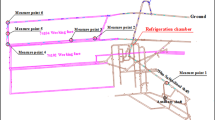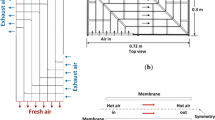Abstract
High temperature heat hazard at mineral mine becomes more and more serious as the increase of mining depth. Heat sources at working faces of mineral mines are complex and are of different characteristics, presenting new challenges for air conditioning systems. In this paper, heat sources at four types of working faces are summarized and their characteristics are investigated. Based on this, simplified equations, which are linear with length of working faces, are proposed to calculate heat dissipation rates. So that the main heat sources of different working faces can be found, and cooling load of air conditioning systems can be calculated. Then, considering main heat sources of coal mines, a typical working face is designed to investigate performances of different ventilation systems and air conditioning systems. Simulation results show that segmented ventilation systems (SC) and heat shield assisted centralized ventilation systems (CCHS) can realize much better temperature distributions at working faces. However, cooling load can be greatly reduced for CCHS, when untreated air is supplied to the coal seam side. Based on this, free cooling assisted air conditioning systems are designed, and annual average energy efficiency ratio (EERann) of the systems are investigated and compared between direct evaporate cooling and indirect evaporate cooling (IEC). For SC, as compared with scenarios without free-cooling, IEC can increase EERann by 15%–23% and 22%–32% under Benxi and Datong ambient conditions, respectively. Besides, to ensure high EERann, CCHS is preferred and it is essential to increase thermal insulation of air ducts.
Similar content being viewed by others
Abbreviations
- B :
-
cutting depth of shearer (m)
- c :
-
specific heat capacity (J/(kg·K))
- COP:
-
coefficient of performance
- D :
-
roof-control distance of working face (m)
- EER:
-
annual average energy efficiency ratio of air conditioning systems
- H :
-
mining height of shearer (m)
- K :
-
heat transfer coefficient (W/(m2·K))
- L :
-
length of working face (m)
- m :
-
mass flow rate (kg/s)
- P :
-
depth (m)
- Q :
-
heat release capacity (W)
- Q AHU :
-
cooling capacity of AHU (W)
- QL :
-
heat release for unit length of working face (W/m)
- t :
-
temperature (°C)
- t gu :
-
original rock temperature (°C)
- U :
-
perimeter of cross section (m)
- v a :
-
air speed (m/s)
- v sh :
-
shear speed (m/min)
- W comp :
-
power consumption of the compressor (W)
- x 1 :
-
electromechanical equipment power density (W/m)
- x 2 :
-
occupant density (person/m)
- x 3 :
-
length coefficient
- x 4 :
-
time coefficient
- x 5 :
-
length convert coefficient
- ρ :
-
density (kg/m3)
- ω :
-
humidity ratio (g/kg)
- a:
-
air
- ambi:
-
ambient condition
- b:
-
backfill
- dew:
-
dew point
- e:
-
electromechanical equipment
- mi:
-
mineral
- o:
-
oxidation
- p:
-
person
- s:
-
surrounding rock
- Sup:
-
supply
- t:
-
mineral transportation
- wb:
-
wet bulb
- τ:
-
time
References
Banks D, Pumar AF, Watson I (2009). The operational performance of Scottish minewater-based ground source heat pump systems. Quarterly Journal of Engineering Geology and Hydrogeology, 42: 347–357.
Cao LM (2017). Mining Machinery. Beijing: China University of Mining and Technology Press. (in Chinese)
Chang DH (2016). General situation and development of mine air cooler. Mining & Processing Equipment, 44(3): 1–4. (in Chinese)
Cui X, Islam MR, Chua KJ (2019). Experimental study and energy saving potential analysis of a hybrid air treatment cooling system in tropical climates. Energy, 172: 1016–1026.
Deng J, Li Q, Xiao Y, et al. (2017). Experimental study on the thermal properties of coal during pyrolysis, oxidation, and re-oxidation. Applied Thermal Engineering, 110: 1137–1152.
Fan JH, Wei ZW (2018). Heat and Moisture Transfer and Heat-Hazard Control for Hot Mine. Beijing: Electronic Industry Press. (in Chinese)
Ghoreishi-Madiseh SA, Hassani F, Abbasy F (2015). Numerical and experimental study of geothermal heat extraction from backfilled mine stopes. Applied Thermal Engineering, 90: 1119–1130.
Guardia C, Schicchi DS, Caggiano A, et al. (2020). On the capillary water absorption of cement-lime mortars containing phase change materials: Experiments and simulations. Building Simulation, 13: 19–31.
Guo PF (2017). Research on cooling technology of 1221(1) working face in Panyi Dong Coal Mine. Anhui University of Science and Technology. (in Chinese)
Heidarinejad G, Bozorgmehr M, Delfani S, et al. (2009). Experimental investigation of two-stage indirect/direct evaporative cooling system in various climatic conditions. Building and Environment, 44: 2073–2079.
Jaber S, Ajib S (2011). Evaporative cooling as an efficient system in Mediterranean region. Applied Thermal Engineering, 31: 2590–2596.
Jian CG (2013). Study on Geothermal Prediction and Cooling Technology in Deep Mining. Beijing: China University of Mining and Technology Press. (in Chinese)
Kranz K, Dillenardt J (2010). Mine water utilization for geothermal purposes in Freiberg, Germany: Determination of hydrogeological and thermophysical rock parameters. Mine Water and the Environment, 29: 68–76.
Min Y, Chen Y, Yang H (2019). A statistical modeling approach on the performance prediction of indirect evaporative cooling energy recovery systems. Applied Energy, 255: 113832.
Rabanillo-Herrero M, Padilla-Marcos MÁ, Feijó-Muñoz J, et al. (2020). Ventilation efficiency assessment according to the variation of opening position in L-shaped rooms. Building Simulation, 13: 213–221.
Riangvilaikul B, Kumar S (2010a). Numerical study of a novel dew point evaporative cooling system. Energy and Buildings, 42: 2241–2250.
Riangvilaikul B, Kumar S (2010b). An experimental study of a novel dew point evaporative cooling system. Energy and Buildings, 42: 637–644.
Sherburne AH, et al. (1982). Guidelines for Mine Cooling. Translated version. Beijing: Coal Industry Press. (in Chinese)
Su W, Darkwa J, Kokogiannakis G (2020). Numerical thermal evaluation of laminated binary microencapsulated phase change material drywall systems. Building Simulation, 13: 89–98.
Tariq R, Sheikh NA, Xamán J, et al. (2019). Recovering waste energy in an indirect evaporative cooler — A case for combined space air conditioning for human occupants and produce commodities. Building and Environment, 152: 105–121.
Tu R, Liu X, Hwang Y, et al. (2016). Performance analysis of ventilation systems with desiccant wheel cooling based on exergy destruction. Energy Conversion and Management, 123: 265–279.
Wang HY, Chen QY, Liu GP (2004). Causes of heat damage and countermeasures in Pingdingshan mining area. Coal Science and Technology, 32(9): 19–22. (in Chinese)
Wang W, Yang DY (2011). Thermal environment analysis and air flow cooling mode selection of working face. Coal Science and Technology, 39(6): 42–45. (in Chinese)
Wang M, Liu L, Zhang X, et al. (2019). Experimental and numerical investigations of heat transfer and phase change characteristics of cemented paste backfill with PCM. Applied Thermal Engineering, 150: 121–131.
Zhang LX (2014). Study on cooling technology and evolution law of temperature field in high temperature mine. PhD Thesis, Liaoning University of Engineering and Technology. (in Chinese)
Zhou YJ, Chu FJ (2003). Heat hazard control of 210807 comprehensive face in Xinji Mine. Mining Safety and Environmental Protection, 30(4): 54–55. (in Chinese)
Acknowledgements
The authors appreciate the support from the National Natural Science Foundation of China (No. 51706015), and from the Fundamental Research Funds for the Central Universities (FRF-IDRY-19-01).
Author information
Authors and Affiliations
Corresponding author
Rights and permissions
About this article
Cite this article
Tu, R., Huang, L., Jin, A. et al. Characteristic studies of heat sources and performance analysis of free-cooling assisted air conditioning and ventilation systems for working faces of mineral mines. Build. Simul. 14, 1725–1736 (2021). https://doi.org/10.1007/s12273-021-0772-0
Received:
Revised:
Accepted:
Published:
Issue Date:
DOI: https://doi.org/10.1007/s12273-021-0772-0




